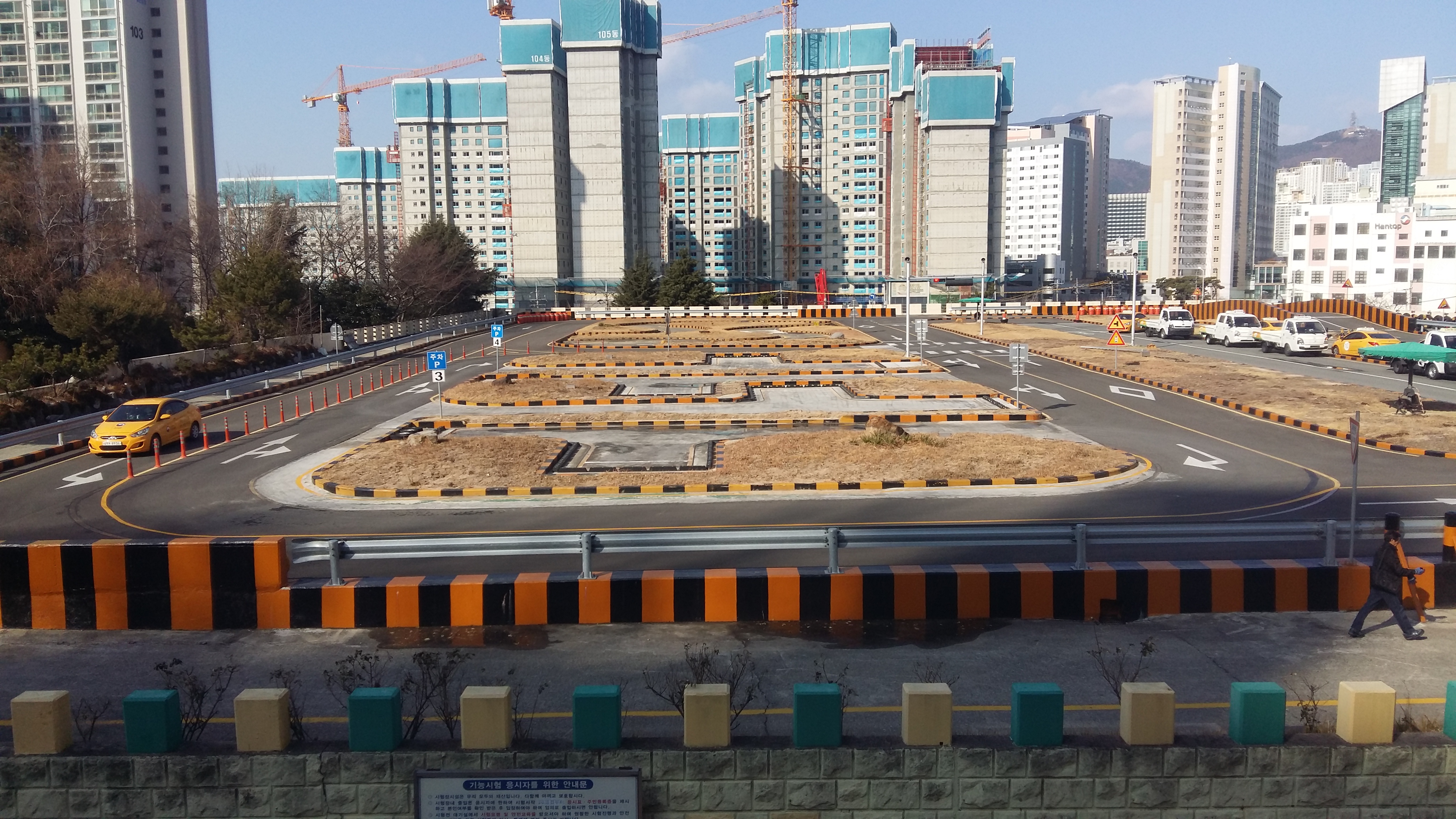How I obtain a driver license in Korea
나의 한국 운전면허 취득기

NamBu Driving Test Center
남부운전면허시험장
This is something I should have done when we first arrived 3-years ago. You can drive in Korea with a UK license and an 'International' version, but you are really supposed to get a Korean License within the first year.
There are two ways to do this;
(1) - you can temporarily hand over your Foreign License in exchange for a Korean one, - In fact this involves a bit of a paper chase - Although you do have to hand over your original licence, you do get it back again if you need to travel overseas. It just means that you need to show valid air tickets.
The other way to do this is
(2), you can start at the beginning and go through the whole Korean test procedure, this does not interfere with your original license. - This is what I chose to do. There is precious little in English on YouTube but you should research and practice as much as possible in advance. Of course you could always try a driving school. By the way the things I mention here all refer to the NamBu Driving Test Center, there may be variations at other test centers.
There are five stages to the test:
1. At the Test Center, fill in a 4-sided form (everyone there is most helpful). You need three passport photos - which you can get at the same office. In the same office you are asked about your health;- a simple tick-box health questionnaire:- Disabilities? Drugs? Alcohol? etc. Next is an eye test chart; "read as I point to the letters" then, colour blindness (the coloured dots).
2. Traffic safety education. - An hour's video (in Korean) showing most of the things that can go wrong during a
normal drive through busy streets, the visuals were quite descriptive. So far so good.
3. Next day, the written exam. This is a multiple choice questionnaire on a screen. All in English, (I believe they offer four different languages) - actually some of the (40) questions are a bit ambiguous as some of the rules here are a little different to the UK - You can overtake on the wrong side, you can turn right against a red light, but look out for motorcycles, bicycles and pedestrians.
4. Next is a sheltered driving course at the Test centre well away from any public roads. This is not difficult but it is very important to follow the instructions exactly.
The Government has partially automated the driving test. Responses are judged electronically and points (from 100) deducted automatically for mistakes.
First of all there is an introductory video (with English subtitles) which explains the course and the requirements. Then you are called and given a car. You sit in the car (alone), - seat belt, adjust seat, mirrors, handbrake, park. -
all standard stuff. Start the engine and don't touch anything. Then the black box screen tells you, in turn, to operate two (of four) of the vehicles controls - it might be headlights, indicators, wipers or gear change. For example:- "You will be asked to operate the indicators" - don't do it yet! In a few seconds another announcement: "Operate the left turn indicator within 5 seconds" - don't do it yet - wait for the timer on the screen to start. Then turn on the left indicator. - don't turn it off! The next announcement is "Turn off the indicator within 5 seconds" - don't do it yet - wait for the timer to start then turn the indicator off. This repeats for one of the other controls.
Then you are told to start the test within 30 seconds. Must use left indicator, and keeping under 20 Km/h you drive a short way to the hill start, (stop on the ramp between two white lines. Hold the car with the handbrake for a minimum of 3-seconds, then drive away smoothly without rolling backwards). Next a left turn, a traffic light "T" junction and then a supervisor will direct you into a T-shaped perpendicular parking area. This is similar to our British 3-point turn, but you can't do it in one continuous smooth movement - it is two bites in to the parking slot - handbrake on - and two bites out again. The area is very tight, you must not touch any of the yellow marker lines except the white 'park' line, which you must cross. And you have a 2-minute time limit. Next you might get the 'random' emergency stop. - Stop within 2-seconds after the alarm, turn on the emergency flashers within 3-seconds and then off again after the warning stops. Drive away, some more 90 degree turns including the traffic light "T" junction again from a different approach.
Next is the 'high-speed' section - after passing the "Minimum speed 20" sign (distinguished by an underline under '20') at no more than 20 km/h drive a short way and increase speed to 25 or more, then reduce speed again to below 20, so you cross the "Max 20" sign well below 20 Km/h. Finally, one last 90 degree turn, then signal right, slow and stop after the white line, park, handbrake, switch the engine off and that's it, the device tells you straight away if you have passed (so far!).
5. The last part is the road test. Another introductory video (again with English subtitles). This is the easy part. With an examiner (and another black box), you drive around a 5-Km public road course. This is only about lane discipline, turns, traffic lights, pedestrian crossings, and generally going with the flow. All of the tricky stuff (hill start, emergency stop etc) is already covered at the driving course. The thing to remember is to anticipate well, take everything slowly, confidently, calmly, quietly and leave plenty of space. The black box gives turn directions (in English) and at the end the examiner tells you if you have passed.
Back at the centre, the Examiner will sign your form, you take it back to the desk, where, with one more photograph, your licence will be issued to you. The license is valid for several years according to your age, and renewal is only an eye test - you don't have to repeat the whole driving test again. The cost altogether is about 70,000 ₩, including photos, or more if any of the stages are repeated. The whole thing takes several days so you need to clear some time in your diary.
And here it is: It was fun and it kept me occupied with something constructive to do for a little while in retirement. - I might even have learned a few things! Happy Motoring!
※ Further info: dl.koroad.or.kr/license/en/index.jsp
한국 운전면허 시험은 사실 3년 전 내가 한국에 처음 왔을 때 해야 했었던 일 중 하나였다. 한국에서는 영국면허증 혹은 국제면허증으로 운전할 수 있지만, 1년 안에 한국면허증을 소지해야 한다.
한국에서 운전면허를 취득하는 두 가지 방법
(1) 일시적으로 외국면허를 제출하고 한국면허와 교환하는 것이다. 사실상 이 방법은 서류상 좀 복잡하다. 기존 면허증을 제출해야 하지만 해외로 다시 나갈 때 항공권만 제시하면 돌려 받을 수 있다.
(2) 다른 방법으로는, 한국면허 시험 과정을 처음부터 밟아나가는 방법이 있다. 이 방법을 통해 취득한 한국면허는 외국면허와 함께 소지해도 상관이 없다. 이 방법이 내가 선택한 방법인데, 유튜브에는 영어로 된 면허 시험 관련 영상을 참고하여 시험 전에 가능한 한 많이 연습해볼 것을 추천한다. 물론 처음부터 자동차학원을 이용할 수도 있다. 참고로 이 글에서 내가 기술한 것은 남부운전면허시험장을 기준으로 하므로 다른 시험장에서의 시험은 각각 조금씩 상이할 수 있다.
면허 시험의 5단계
1. 시험장에서 4장의 서류를 작성한다. 시험장 직원들이 작성에 필요한 도움을 주기 때문에 걱정할 필요는 없다. 3장의 여권용 사진이 필요한데, 현장에서 바로 사진 촬영이 가능하다. 건강에 대해서도 질문을 하는데 장애, 마약, 술 등에 관해 간단히 체크만 하면 되는 질문들이다. 시력검사와 색맹검사도 해야 한다.
2. 다음으로, 약 한 시간 가량의 영상을 통해 도로에서 운전을 할 때 발생할 수 있는 위급상황들에 대해 시청하는 교통안전교육을 받는다. 한국어밖에 지원되지 않지만 영상만으로도 충분히 이해할 수 있는 내용이다. 지금까지의 과정에서는 특별히 어려운 점은 없다.
3. 다음은 필기시험으로, 컴퓨터로 이뤄지는 선다형 시험이다. 모든 문제는 영어로 제공되고 총 4가지 언어로 제공된다. 총 40문제 중 몇 문제는 명확하지 않은 부분이 있었는데, 한국과 영국이 조금 다른 교통규칙을 가지고 있어서이기 때문이다. 예를 들면, 다른 방향으로 추월할 수 있고, 빨간 불일 때 우회전을 할 수 있지만 오토바이, 자전거, 보행자를 조심해야 한다는 점 등이었다.
4. 다음은 공공도로에서 멀리 떨어진 시험장 내에서 이뤄지는 장내운전시험이다. 어렵지는 않지만 주어지는 지시들을 정확히 따르는 것이 가장 중요하다. 한국 정부는 장내운전면허시험을 부분 자동화했다. 운전은 전자로 채점되고 실수를 하면 자동으로 감점된다.
장내운전면허시험을 치러 가면 먼저 경로와 규칙을 설명하는 소개 영상을 본다. 영어자막 제공도 제공된다. 영상 시청 후, 호명되면 시험을 볼 차를 배정받는다. 운전석에 앉아서 안전벨트를 매고, 좌석과 거울, 기어를 조정하고 주차한다. 모두 기본적은 것들이다. 그리고 시동을 걸고는 아무것도 동작하지 않는다. 잠시 뒤 검은 화면이 아래와 같이 차례로 4개 중 2개의 동작들을 하도록 지시한다. 상향등, 지시등, 와이퍼나 기어 변속 등이 이에 포함된다. 예를 들어 “이제 지시등을 동작해야 합니다.” 이 때는 아직 아무것도 동작하면 안 된다. 몇 초안에 다른 안내가 나온다. “좌측 지시등을 5초안에 켜세요.” 이 때 또한 아직 동작하면 안되고 타이머가 스크린에서 시작할 때까지 기다려야 한다. 좌측 지시등을 키고 나서는 바로 끄면 안 된다! 그 다음 안내인 “지시등을 5초 안에 끄세요”가 나오더라도 타이머를 기다렸다가 지시등을 끈다. 이 과정이 다음 동작 시험에서 반복된다.
그 다음 30초안에 본 시험을 시작하게 된다. 좌측 지시등을 사용하여 20km 미만의 속도를 유지하면서 언덕이 시작
하기까지의 짧은 거리를 주행해야 한다.(두 흰색 선 사이에서 멈춘다. 최소 3초 동안 기어로 차를 멈추고 후진 없이 부드럽게 주행한다.) 다음은 T자 교차로에서 신호를 받고 좌회전하고 나면 감독관은 T자형 주차 공간으로 가도록 지시한다. 이것은 영국의 3점 회전과 비슷한데 한번의 동작으로 멈춤 없이 수행하기에는 어려움이 있으므로 주차공간에 가려면 두 번에 걸쳐 동작하는 것이 좋다. 이 때 기어를 넣고 나서 다시 2 동작으로 나뉜다. 공간이 매우 협소해서 지나가야 하는 하얀 주차선 외에 노란 선을 건드리지 않도록 주의한다. 이 때 주차는 주어진 제한시간 2분 내에 마쳐야한다.
시험 중 예고 없이 비상정지 신호를 받을 수 있는데 이때는 2초간 멈추었다가 3초간 비상등을 키고 경고가 멈추면 다시 끈다. 주행하다가 다른 지점에서 진입하는 T 교차로를 포함한 90도 회전을 몇 번 더 한다.
다음은 고속주행구간이다. “최소20” 표지판을 지나고 나서 20이하의 속도로 짧게 주행하고(20이라는 숫자 아래에 밑줄이 있다.) 25정도 혹은 이상으로 속도를 높인다. 그리고 속도를 다시 20이하로 줄이고 “최대20” 표지판을 지난다. 마지막 90도 회전에서 우회전 신호를 받아 흰 선 앞에서 천천히 멈췄다가 주차하고 기어를 넣고 시동을 끄면 끝이다. 끝난 다음엔 곧 바로 주행 기기가 합격했는지 알려준다. 하지만 끝이 아니다!
5. 마지막 단계는 도로주행시험으로, 어렵지는 않다. 감독관과 주행시험기와 함께 5 키로의 도로의 코스를 주행한다. 차선 유지, 회전, 교통신호, 횡단보도 주행에 관한 시험으로 기본적으로 교통상황에 맞게 주행하면 된다. 경사로 주행, 비상정지 같은 까다로운 부분은 장내주행시험에서 다뤄졌기 때문에 기억할 것은 주위를 잘 살피며 천천히 주행하고 자신감 있고, 침착하게 운전하며 충분한 공간을 확보하며 운전하는 것이다. 주행시험기기는 영어로 회전 방향을 알려주고 마지막에는 감독관이 합격하였는지 알려준다.
다시 시험장으로 돌아와 감독관이 양식에 사인을 해주면 사인된 양식을 사진과 함께 직원에게 가지고 가면 면허증이 발급된다. 면허증은 연령에 따라 몇 년간 유효하며 갱신 시 전 시험을 반복할 필요없이 시력검사만 하면 된다. 시험 비용은 사진을 포함하여 7만원 정도이며 재시험 시 추가 비용이 발생할 수 있다. 시험 전체 과정에 몇 일씩 소요되므로 개인의 일정을 확보한 후 시작하는 것이 좋다.
은퇴 후에 새로운 것에 도전하였다는 점이 뿌듯하였고, 새로운 것을 또 하나 배웠다! 부디 즐거운 운전하시길!
※ 세부정보: dl.koroad.or.kr/license/en/index.jsp
Contributing Writer l Stephen Tait (스티븐 테이트)

I am a Manufacturing Engineer specialising in Automotive components. My first introduction to Korea was in 1982 when my Company, Lucas Diesel Systems, asked me to join our Changwon Fuel Injection Company for five years as Quality Manager. While in Korea in 1985, I met and married my wife KyongHee, hence, our return to Korea three years ago following my retirement. Lately, I am trying to learn the Korean Language at BFIC.
나는 자동차 부품 전문 엔지니어입니다. 처음 한국에 온 것은 1982 년 당시 다니던 회사인 루카스 디젤 시스템(Lucas Diesel Systems)에서 창원지점에 5 년간 품질 관리자로 참여하라고 했을 때였습니다. 1985 년, 아내인 경희를 만나 결혼했고, 퇴직 후 3 년 전 한국으로 돌아 왔습니다. 최근에는 부산국제교류재단의 한국어강좌를 수강하며 한국어를 배우고 있습니다.

